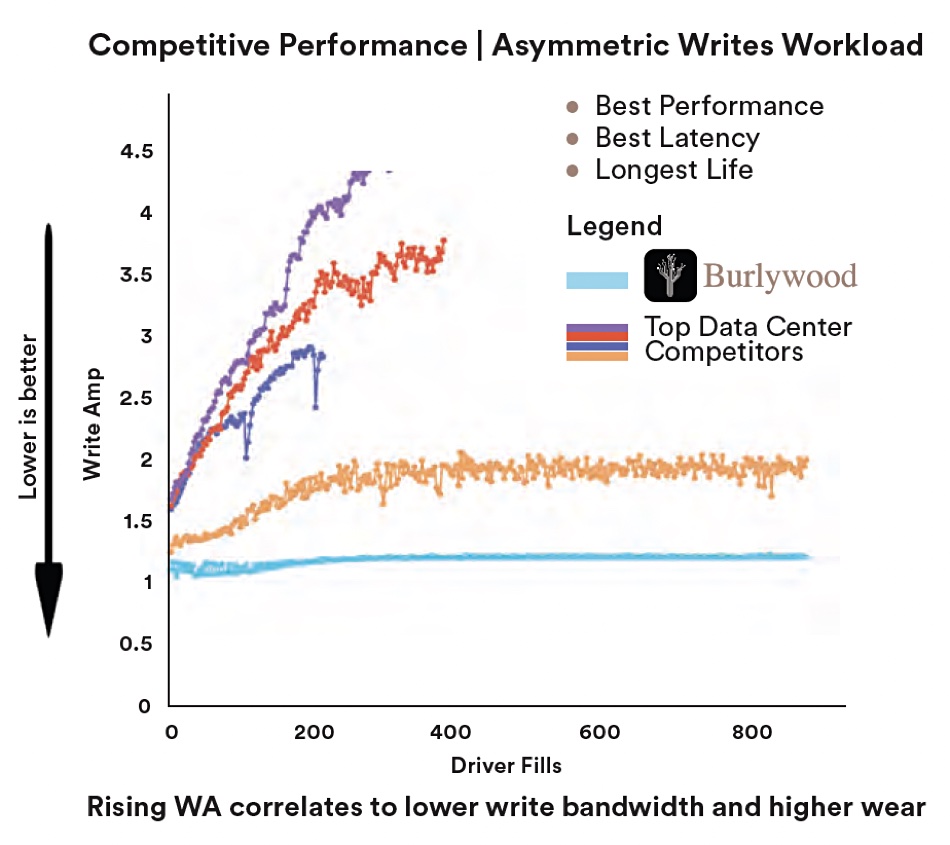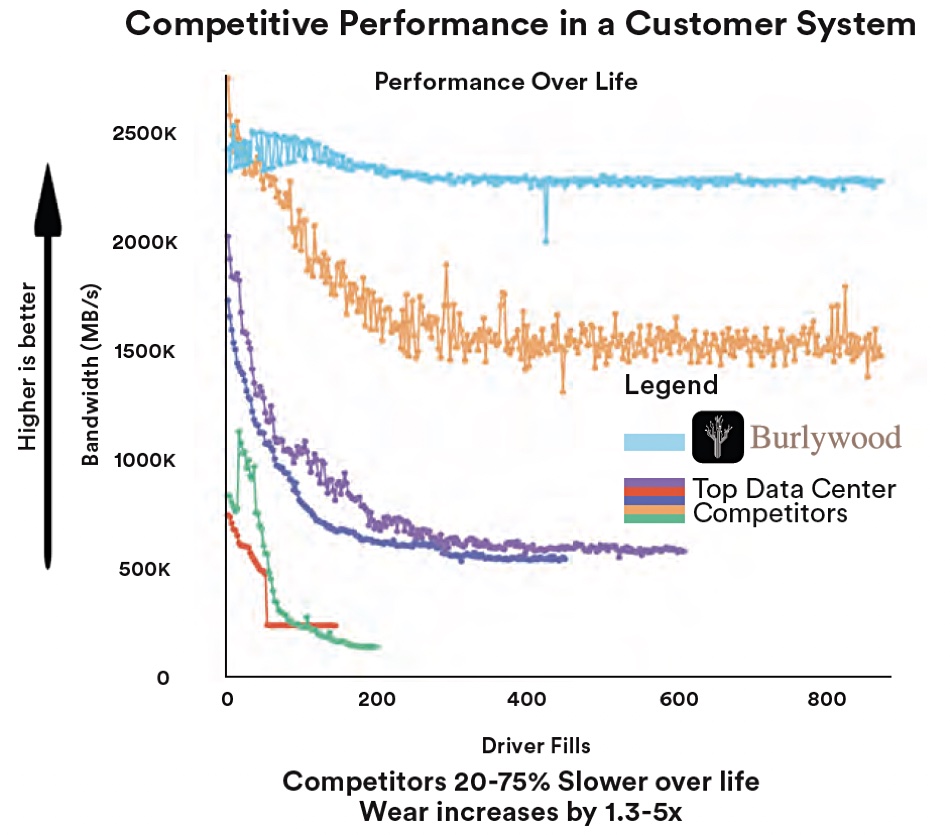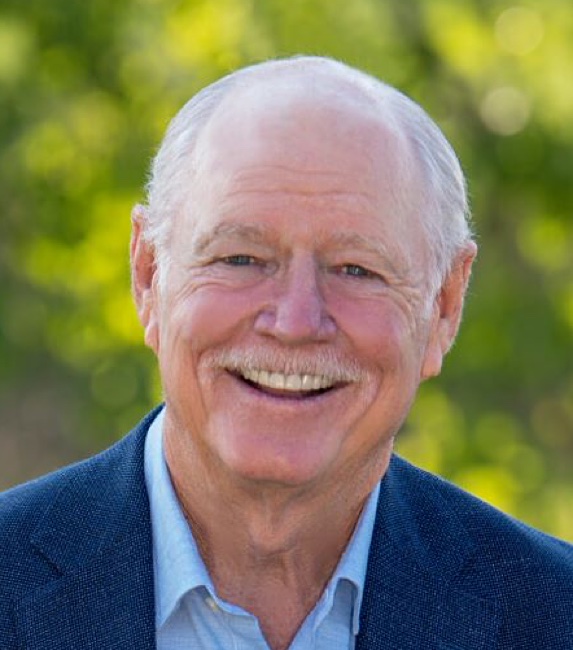SSD controller startup Burlywood has launched its FlashOS software to build software-defined SSDs claiming the longest-lasting drive performance in the industry – but gave few detailed numbers to back it up.
FlashOS firmware is supposed to analyze application performance at the flash controller level, then tune the SSD’s performance to improve it for better production application performance and endurance. Firmware is loaded into an SSD’s controller and acts as the drive’s operating system – also called the Flash Translation Layer, as it converts host logical addressing to physical drive mapping.
Burlywood CEO Mike Jones said: “FlashOS will transform what the industry expects from an SSD and ignite the next wave in datacenter innovation.” CTO and founder Tod Earhart added: “In the market today, datacenter workloads are not being met. We are excited to bring FlashOS to cloud and datacenters that are tired of simply accepting SSD performance failure rates.”
The promised feature list includes:
- Self-Adaptive Architecture driven by real production workload analysis, provides visibility for data placement intelligence to optimize performance and efficiency;
- Data Stream splitting to NAND physical partitions minimizes the noisy neighbor problem;
- Longest-lasting drive performance in the world;
- Best in class latency consistency, eliminating spikes;
- Lower Total Cost of Ownership (TCO) through higher endurance;
- Advanced software algorithms with a flexible base, enables rapid adaptation to changing production workloads;
- Best performing applications in write-heavy workload environments.
Burlywood says an unnamed premier European storage manufacturer was the first to embrace FlashOS before its public release. Its production SSD is specifically designed and optimized for typical datacenter workloads. It claims the disk delivers “2–5x” better performance with a steady state, consistent latency, and endurance over its life under real-world, complex workloads without any host modifications.

It also claims customers realize 2x greater drive endurance resulting in a significant reduction in drive replacements over the life of the platform. But no actual numbers are supplied.
This sounds great – doubled drive endurance, no latency spikes for consistent performance, and great write-heavy performance. How do you get it? Burlywood says customers can realize the benefits of FlashOS in two different ways. The first is buying SSD drives directly from one of the manufacturers using its controller in their SSDs – but it doesn’t say who these manufacturers are.
The second is by licensing FlashOS and using Burlywood’s SSD reference design to have one of its contract manufacturing partners build SSDs to its specifications.
A Burlywood product sheet document talks about a FlashOS SSD in 2.5-inch, U.3 format with 8TB capacity using TLC NAND and a PCIe 4 x4, NVMe 1.4 interface. Its sequential read and write performance numbers are up to 7GB/sec reading and 4GB/sec writing. That’s pretty similar to Intel D7-P5500/5600 and Solidigm D7-P5520/5620 PCIe 4 SSDs. The endurance is not revealed, but charts show the FlashOS SSD’s superiority in write workloads and consistent bandwidth and write latency over time.

Comment
Effectively these FlashOS SSDs are out of reach unless you are a large enterprise/hyperscaler customer who can afford the time, complexity, and expense involved in having Burlywood arrange a contract manufacturer for you.
It needs to answer the question of why you would bother, when FADU partner SK hynix can supply a 2, 4 or 8TB PCIe 4 SSD with FADU’s FC4121 controller, which is claimed to deliver the industry’s highest PCIe 4 performance with consistent low latency and superior QoS. The write performance is up to 7.2GB/sec and read performance is up to 4.4GB/sec – faster than the FlashOS SSD. This FADU SSD, on the other hand, is a relatively known quantity compared to the FlashOS SSD.

Burlywood was started up in 2015 in Longmont, Colorado, by then-CEO Tod Earhart, and its initial financing was funded primarily by angel investors, not VCs. It had a $1.4 million round in 2017 and a $10.6 million A-round in 2018. The A-round was led by Michael Jones and John Scarano with participation from Acadia Woods Partners. There has been no subsequent funding.

Jones became CEO in April this year. LinkedIn shows 13 Burlywood employees, most focused on firmware, and just three executives – CEO, CTO, and an operations/HR person. A spokesperson said: “Mike has an extensive technology background, having built, and led several thriving high-tech companies. He was inspired by the opportunity he saw to bring meaningful innovation to the storage industry, providing better SSD performance for data centers and enterprises. Mike is leveraging his experience in launching and building successful companies to help Burlywood launch its flagship product and rapidly scale its presence in the storage market.”
FlashOS could be great SSD firmware, but Burlywood needs a way to get more detail on that out to prospective customers. At the moment, we can’t see how it is going to ignite the next wave in datacenter innovation without a major increase in market presence and momentum.








